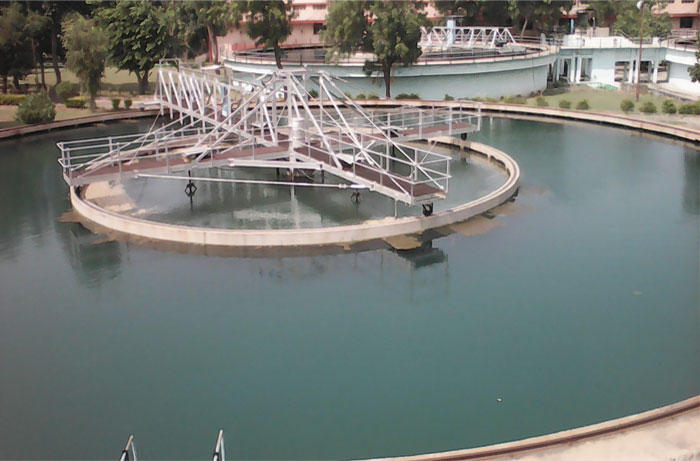Flocculator
 testing centers to determine the number of treatment chemicals and the order they should be added.The term derives from flocculation, a chemical process in which a substance that is suspended within another substance emerges as a floc (or flake), generally following the addition of a clarifying agent. Coagulation flocculation is a method of water treatment and purification that includes adding substances to induce the clumping of undesired particles into bigger flocs for easier separation.Laboratory FlocculatorsWhile larger paddle wheel or turbine flocculators are used in water treatment plants, smaller-scale flocculators, also known as jar testers, test small batches.Plants save money by allowing lab workers to refine their treatment options by doing pilot-scale experiments with a jar tester. Jar testing mimics the coagulation and flocculation processes found in water treatment plants. The production and settling of floc may be detected in a sample by stirring it, much as it would be in a plant.Smaller sample sizes in the lab make it easy to change the chemical dose and order in which they’re applied. As a result of the improved settling outcomes, the full-scale treatment center’s chemical use is reduced. Other factors that may be changed and dose include chemical kinds, mixing rate, aeration level, aeration time, and filter type.Flocculator OptionsLaboratory flocculators can hold a variety of beakers or jars, allowing several samples to be tested simultaneously. To find the most successful course of action, lab workers add the same quantity of water to each beaker while treating each sample with different amounts of chemicals or applying the chemicals in a different order.Some flocculators, such as the VelpScientifica FP4, may be powered by an internal battery or a 12V car or truck cigarette lighter connection for on-site use. For further mobility, VelpScientifica offers an extra carrying case.Consider additional aspects and how they’ll affect your work when choosing a flocculator. Considerations include maximum speed, variable speed capabilities, and an adjustable height for stirring blades.The biological system is built around the sludge’s age. In a normal activated-sludge system, the sewage must be retained in the reactor for roughly 5 to 7 hours. The biomass stays in the reactor for around ten days due to sludge recycling from the secondary filter. In most sewage treatment plants, disinfection comes after secondary treatment and clarifying. Chlorine is mainly used for disinfection.Before disinfection in a few sewage treatment plant facilities, a different step is used. This stage is known as advanced therapy or tertiary treatment. Infiltration to sand, ion exchange, adsorption to activated carbon, various membrane processes, coagulation-flocculation, nitrification-denitrification, and fine screening are the most extensively utilized advanced systems involved. Other challenges may arise due to industrial waste, requiring the use of advanced technology.Generally, there are many things you can do to learn more about Flocculator Plant System in Pune. These factors could certainly help make you fully grasp far more the idea behind Flocculator Plant in Mumbai. Study more by browsing our Depuro water website right now.
testing centers to determine the number of treatment chemicals and the order they should be added.The term derives from flocculation, a chemical process in which a substance that is suspended within another substance emerges as a floc (or flake), generally following the addition of a clarifying agent. Coagulation flocculation is a method of water treatment and purification that includes adding substances to induce the clumping of undesired particles into bigger flocs for easier separation.Laboratory FlocculatorsWhile larger paddle wheel or turbine flocculators are used in water treatment plants, smaller-scale flocculators, also known as jar testers, test small batches.Plants save money by allowing lab workers to refine their treatment options by doing pilot-scale experiments with a jar tester. Jar testing mimics the coagulation and flocculation processes found in water treatment plants. The production and settling of floc may be detected in a sample by stirring it, much as it would be in a plant.Smaller sample sizes in the lab make it easy to change the chemical dose and order in which they’re applied. As a result of the improved settling outcomes, the full-scale treatment center’s chemical use is reduced. Other factors that may be changed and dose include chemical kinds, mixing rate, aeration level, aeration time, and filter type.Flocculator OptionsLaboratory flocculators can hold a variety of beakers or jars, allowing several samples to be tested simultaneously. To find the most successful course of action, lab workers add the same quantity of water to each beaker while treating each sample with different amounts of chemicals or applying the chemicals in a different order.Some flocculators, such as the VelpScientifica FP4, may be powered by an internal battery or a 12V car or truck cigarette lighter connection for on-site use. For further mobility, VelpScientifica offers an extra carrying case.Consider additional aspects and how they’ll affect your work when choosing a flocculator. Considerations include maximum speed, variable speed capabilities, and an adjustable height for stirring blades.The biological system is built around the sludge’s age. In a normal activated-sludge system, the sewage must be retained in the reactor for roughly 5 to 7 hours. The biomass stays in the reactor for around ten days due to sludge recycling from the secondary filter. In most sewage treatment plants, disinfection comes after secondary treatment and clarifying. Chlorine is mainly used for disinfection.Before disinfection in a few sewage treatment plant facilities, a different step is used. This stage is known as advanced therapy or tertiary treatment. Infiltration to sand, ion exchange, adsorption to activated carbon, various membrane processes, coagulation-flocculation, nitrification-denitrification, and fine screening are the most extensively utilized advanced systems involved. Other challenges may arise due to industrial waste, requiring the use of advanced technology.Generally, there are many things you can do to learn more about Flocculator Plant System in Pune. These factors could certainly help make you fully grasp far more the idea behind Flocculator Plant in Mumbai. Study more by browsing our Depuro water website right now.




